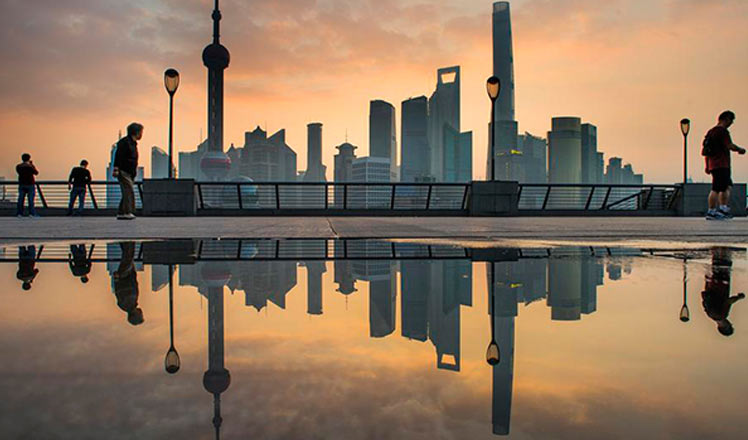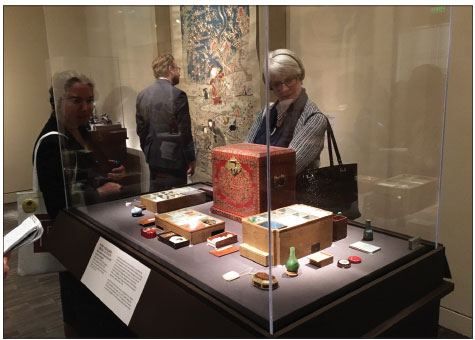Emperors' human side revealed
Updated: 2016-06-16 10:36
By Lia Zhu In San Francisco(China Daily USA)
|
||||||||
|
Visitors examine the craftsmanship of Emperor Qianlong's treasure box, within which are three smaller boxes, containing 44 objects made of porcelain, bronze, agate, ivory and fruit seeds, dating from the ancient times to the 18th century. Lia Zhu / China Daily |
The legendary emperors of China had a human side too.
Museum goers in San Francisco will get an intimate glimpse into the artistic and personal lives of Chinese emperors from the 12th to 20th century through a collection of their most cherished belongings.
An exhibition titled Emperors' Treasures, on display from June 17 through Sept 18 at the Asian Art Museum in San Francisco, will showcase nearly 150 pieces of imperial artwork, including exquisite paintings, ceramics and jades.
The exhibition explores the identities of nine key rulers - eight emperors and one empress - and how their tastes shaped not only the imperial court, but Chinese aesthetics as well.
On loan from the Taipei Palace Museum, the show has traveled to the US before, in the 1960s and again in 1995, but many of the items in this exhibition are coming to the US for the first time.
The stories behind the objects were never told from an angle that aims at making the emperors human and offers intimate moments with the audience, said Jay Xu, curator of the exhibition and director of the Asian Art Museum.
"We don't want those emperors to assume remote, abstract and intimidating postures," he said. "This exhibition is designed to enable our audience to have a very intimate encounter with past emperors, to humanize them through the works of art that they created, commissioned or collected to tell a human story about who they were."
The highlights include the masterful landscape and calligraphy of Emperor Huizong, recognized for his distinctive, influential "slender-gold" script.
Xu explained that unlike in the West, Chinese emperors' portraits were only stored in ancestral temples rather than hung on the wall, so calligraphy was very important as one's personality was expressed by it.
Another rare exhibit is a blue and white Ming flat vase, depicting Western Asian entertainers, one of only two surviving in the world. It illustrates both Ming Dynasty porcelain craftsmanship and cultural exchanges between China and the outside world in the early 15th century.
The "holy grail" of Chinese porcelains - a wine cup with a cock and hen with three chicks - is not only rare but also "striking", said Xu.
"The image of the rooster, mother hen and three chicks is very warm and homely. It's a family portrait of an ordinary coop," he said. "Why on earth would an emperor want to choose this image for one of his most precious cups? I think you can relate to a yearning for family."
Among the objects brought to the US for the first time is the celebrated "meat-shaped stone," a jasper stone intricately carved to resemble a portion of braised pork belly.
"Those emperors lived in the largest palace in the world, and yet they liked to stay in a small private corner and play with the small objects as toys, as cultural nourishment.This is their human side," said Xu.
In honor of the stone's unusual appeal, more than a dozen San Francisco chefs, both up-and-coming and established, will feature versions of the mouthwatering, slow simmeredbraised pork belly in their restaurants, and the museum's caf will offer the dish to visitors throughout the exhibition's run.
liazhu@chinadailyusa.com
- Planned Obama, Dalai Lama meeting protested
- Gravitational waves detected for second time: scientists
- 48-hour 'silence regime' starts in Syria's Aleppo
- UN Security Council adopts resolution on Libya arms embargo
- US extradites top drug lord 'El Guero Palma' to Mexico
- Houston firm joins China clean energy project

 Floods cause havoc across south, central China
Floods cause havoc across south, central China
 Top 10 Chinese cities with highest housing rent
Top 10 Chinese cities with highest housing rent
 Polish art rediscovers its roots
Polish art rediscovers its roots
 'Zen harvest' in Shaolin Temple
'Zen harvest' in Shaolin Temple
 Handsome salary of helicopter pilot lures college applicants
Handsome salary of helicopter pilot lures college applicants
 Rio Olympics unveils medals
Rio Olympics unveils medals
 New photos capture life in China
New photos capture life in China
 Fair ladies at Royal Ascot
Fair ladies at Royal Ascot
Most Viewed
Editor's Picks

|

|

|

|

|

|
Today's Top News
Abe's blame game reveals his policies failing to get results
Ending wildlife trafficking must be policy priority in Asia
Effects of supply-side reform take time to be seen
Chinese State Councilor Yang Jiechi to meet Kerry
Chinese stocks surge on back of MSCI rumors
Liang avoids jail in shooting death
China's finance minister addresses ratings downgrade
Duke alumni visit Chinese Embassy
US Weekly

|

|








